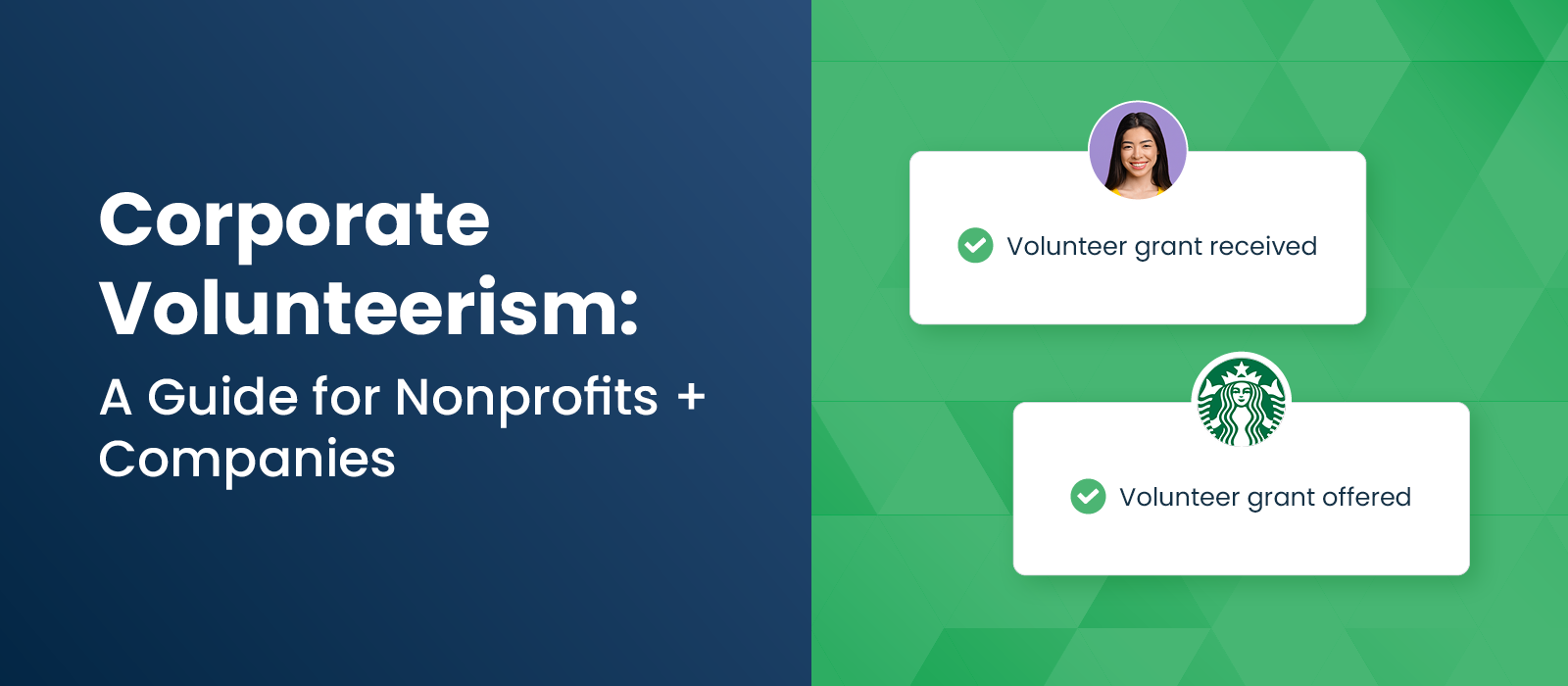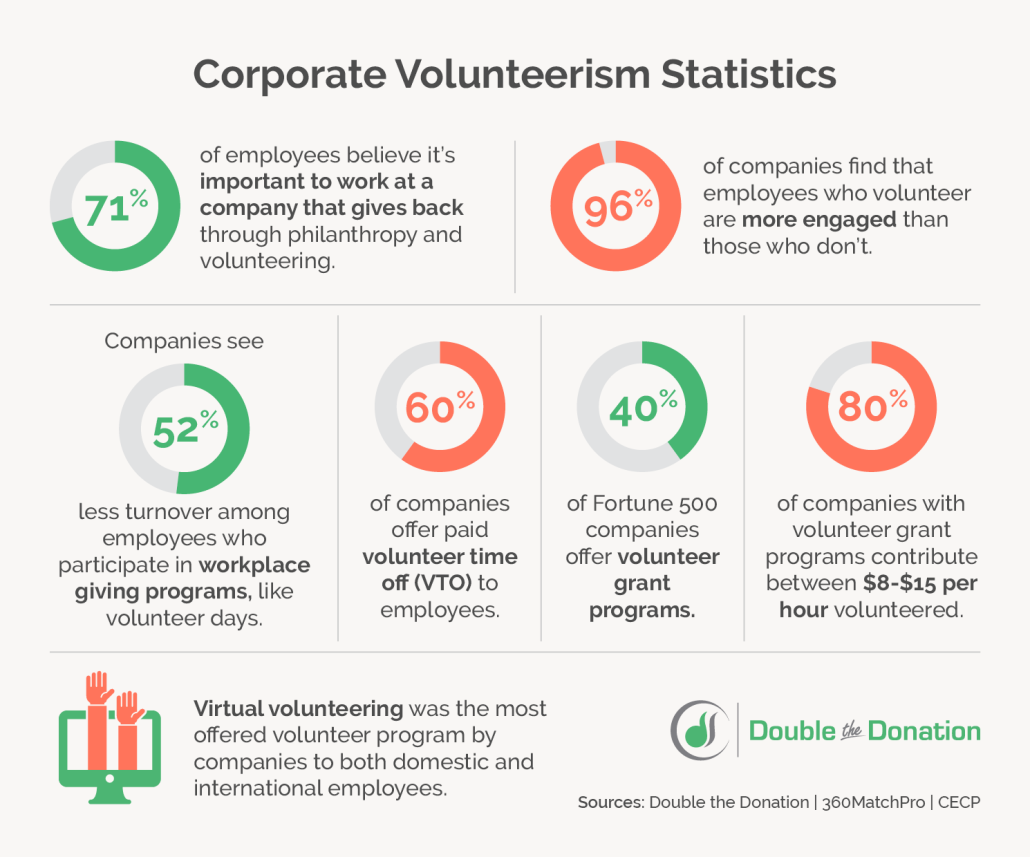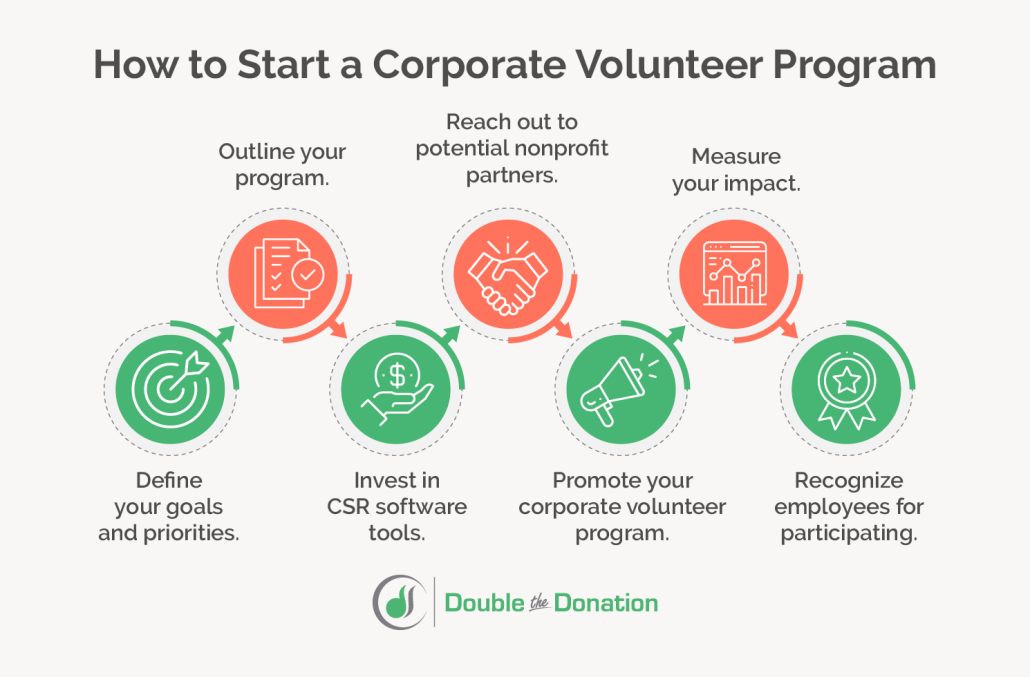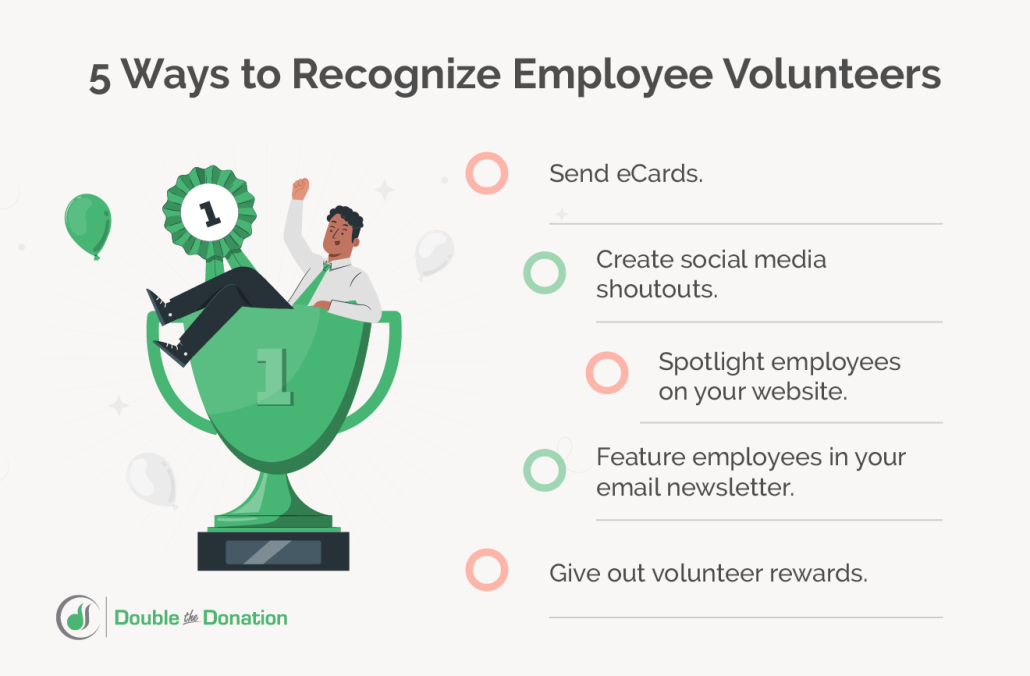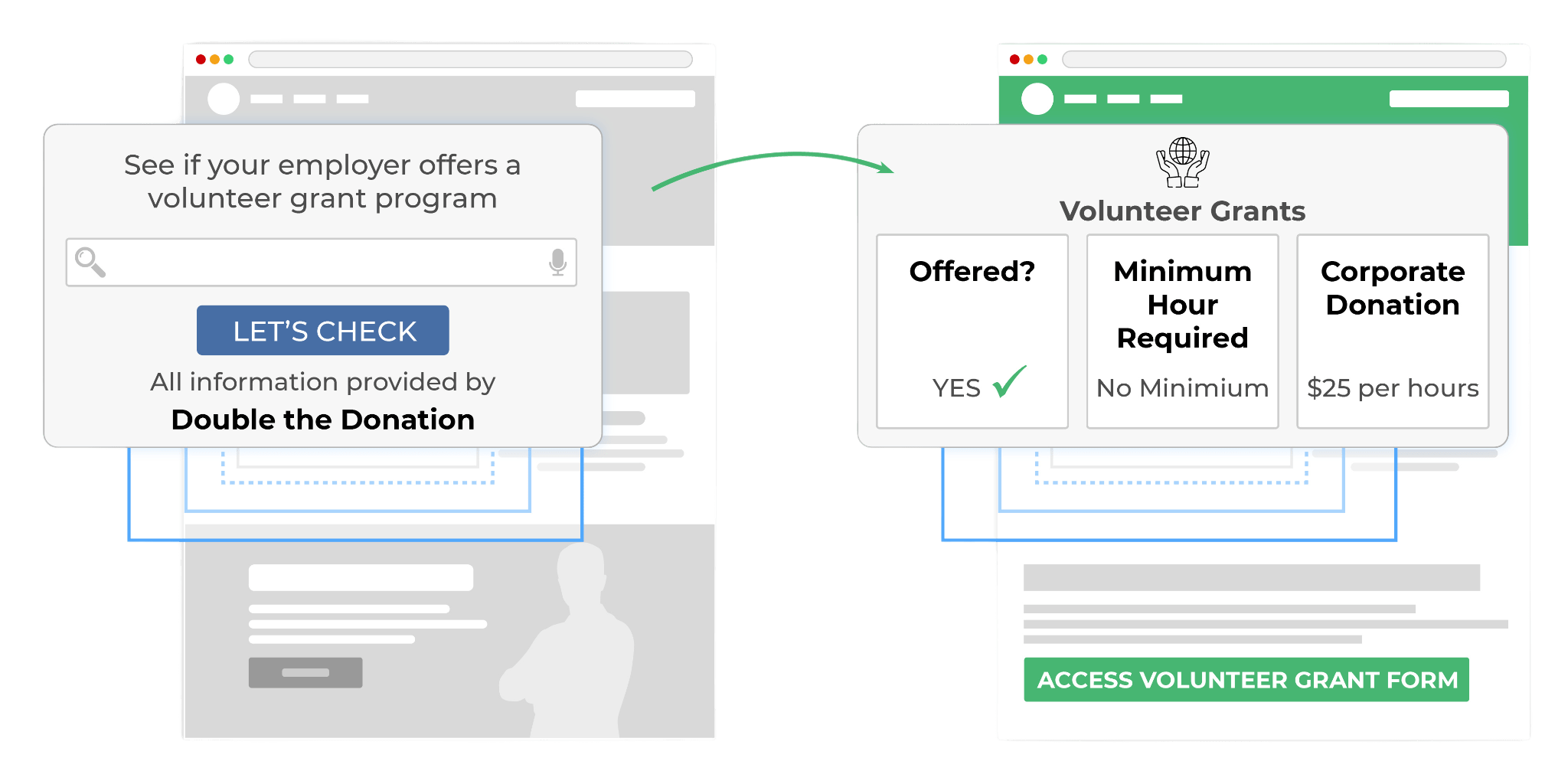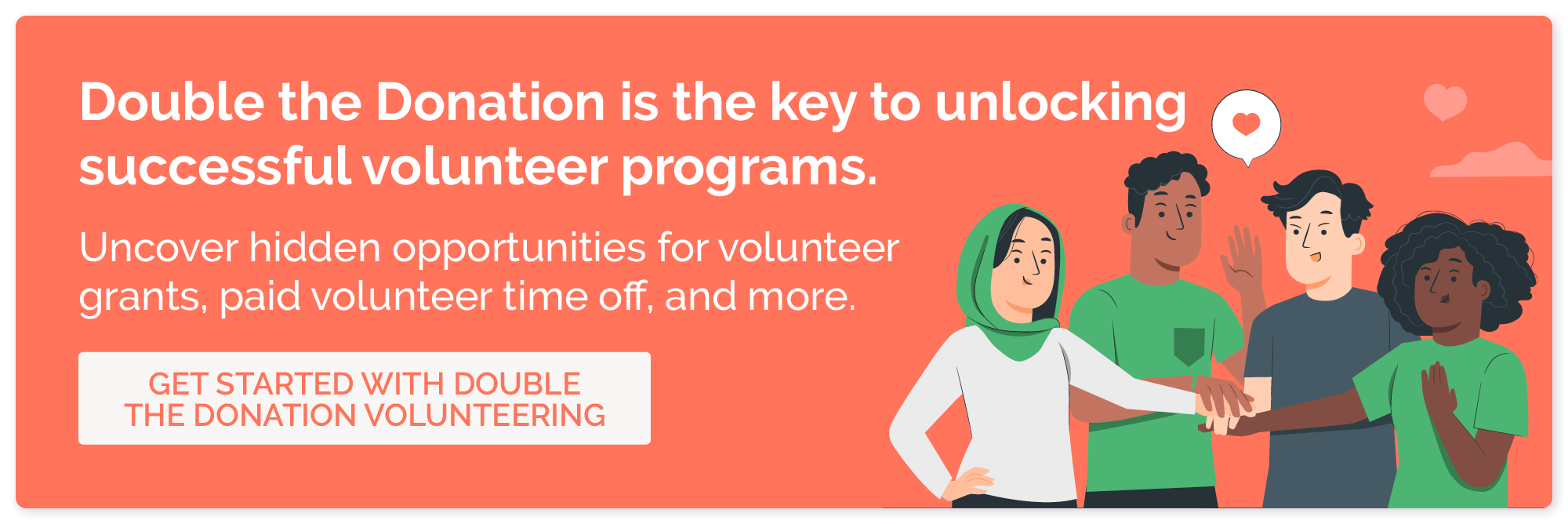Corporate Volunteerism: A Guide for Nonprofits + Companies
Corporate volunteerism is a concept that has grown significantly in recent years. As organizations recognize the value of corporate social responsibility and community engagement, both nonprofits and companies have discovered the potential benefits of volunteer programs.
Whether you’re a nonprofit seeking to forge strong partnerships with businesses or a company looking to boost employee engagement through volunteerism, this guide provides insights into how both sectors can create mutually beneficial relationships through corporate volunteerism.
We’ll cover:
- Corporate Volunteerism: FAQs
- 7 Corporate Volunteering Statistics You Should Know
- How to Start a Corporate Volunteer Program (For Companies)
- How to Attract Corporate Volunteer Support (For Nonprofits)
- 4 Top Corporate Volunteerism Examples to Be Inspired By
Corporate volunteerism accomplishes great things through the combined efforts of companies, nonprofits, and volunteers. Ready to find out how you can make the most of it? Let’s begin with the basics.
Corporate Volunteerism: FAQs
Before we delve into specific tips and tactics, let’s set the stage by walking through some frequently asked questions about corporate volunteerism:
What is corporate volunteerism?
Corporate volunteerism is an aspect of corporate philanthropy that involves encouraging employees to commit their time and skills to charitable causes in their communities. To do this, companies establish corporate volunteer programs that formalize these activities and track their overall impact.
It’s a win-win arrangement: companies help address social issues, employees gain a sense of fulfillment and personal growth, and nonprofits receive valuable support that furthers their missions. These volunteering programs serve as an excellent way to deepen partnerships across the corporate-nonprofit sectors, creating long-term collaborations that benefit both parties.
Corporate volunteer programs can take many forms, from employees donating their time to help with specific tasks for a nonprofit to offering specialized skills like web development, legal counsel, or financial advice. Additionally, many companies support their employees’ volunteering efforts by offering paid time off (Volunteer Time Off or VTO) or creating volunteer grant programs that reward employees with donations to their chosen charities based on the hours they contribute.
What are the benefits of employee volunteer programs for nonprofits and companies?
Corporate volunteerism brings a host of benefits to everyone involved: the company, its employees, and the nonprofits they serve. But what does that look like in action?
For example, nonprofits benefit from:
- Increased Volunteer Capacity: Nonprofits, particularly smaller organizations, often struggle with limited human resources to meet the growing demands of their communities. Corporate volunteer programs provide a reliable, skilled workforce that can assist with a wide variety of tasks.
- Access to Professional Skills: Often, corporate employees are highly skilled in areas like accounting, law, marketing, web development, and project management. Through skills-based volunteerism programs, nonprofits can leverage these skills without having to shell out the funds for consultants or experts.
- Increased Visibility and Publicity: Companies often publicize their volunteer initiatives, both internally to employees and externally through public relations channels. As a result, your nonprofit may gain more awareness in the community and potentially attract new supporters or donors.
- Long-term and Sustainable Relationships: When a company engages its employees in volunteer efforts with your nonprofit, this is often just the beginning. Over time, these relationships can extend beyond volunteering and may lead to donations, event sponsorships, or even shared goals on larger social issues.
Meanwhile, for business-specific benefits, engaging in corporate volunteerism allows you to:
- Engage more employees. Many employees need more than just a regular paycheck to feel invested and fulfilled in their roles. Corporate volunteering initiatives allow them to develop a sense of pride in working for your company since they’re able to contribute to positive change within their communities.
- Enhance your reputation. These days, customers expect more from companies than just stellar products or services. They want to know that your business strategy involves more than making profits. Through corporate volunteerism, your company can prove its commitment to social good and attract more customers.
- Attract top talent. According to PwC, 65% of people around the globe want to work for an organization with a powerful social conscience. Creating and publicizing your company’s employee volunteer program guidelines is an excellent way to catch the attention of socially conscious job seekers.
- Develop employee skills. Through volunteering, employees can gain experience and develop abilities they can later apply on the job. This can be anything from leadership skills to technical expertise, like coding. Plus, by organizing team-wide volunteering events, you can foster improved collaboration and communication within the workplace.
- Improve employee well-being. According to the Mayo Clinic Health System, volunteering can improve a person’s physical and mental health, reducing stress and decreasing the risk of general illness. By encouraging employee volunteering, your company can ensure that they report to work each day feeling ready and eager to put in their best efforts.
As you can see, there are a lot of wins on both sides when it comes to corporate volunteering. And that’s not even getting into the benefits to volunteers who get involved!
What are the different types of corporate volunteering?
Corporate volunteerism initiatives come in several shapes and sizes. Consider these popular types of employee volunteering to include or target in your programming:
- Direct Service Volunteering. Through this type of volunteering, employees directly interact with nonprofit beneficiaries and community members. For example, they may provide tutoring sessions to local students, walk dogs at an animal shelter, or serve meals to people without permanent housing.
- Indirect Service Volunteering. Indirect service volunteering does not involve interactions with beneficiaries. Instead, employees can support their community by assembling care packages, participating in a beautification project, or creating marketing materials online.
- Skills-Based Volunteering. Also called SBV, this type of volunteering allows employees to make use of their professional skills to advance nonprofit missions. For instance, employees at a law office may provide pro bono legal services to a charitable organization, while those at a web development company may revamp a nonprofit’s website for free.
- Volunteer Grants. A volunteer grant program rewards employees for committing their time and skills to causes they care about. Typically, once they’ve volunteered a minimum number of hours with a nonprofit, they can submit a volunteer grant request to your company. Then, you donate a certain amount of money to that nonprofit, depending on how many hours the employee volunteered.
- Volunteer Time Off. You can think of Volunteer Time Off, or VTO, as a short-term employee internship. Companies generally offer their staff between 8 and 40 hours each year to participate in volunteer activities, such as direct, indirect, or skills-based volunteering, while still receiving their regular paycheck.
- Team Volunteering. These volunteer opportunities double as team-building events for your company. Many nonprofits need larger teams of corporate volunteers to assist them with projects, from constructing houses to participating in a local cleanup activity.
- Mentorships. Through mentorships, employees can make a direct impact on an individual community member’s life. This may involve supporting a student’s personal goals and academic performance or helping a young professional along their career path.
- Employee Internships. Some companies lend their employees to nonprofit organizations by allowing them to participate in internships, enabling employees to provide their skills to the nonprofit over the long term. During these internships, your business will continue paying employees’ salaries. Patagonia, for example, permits any employee within the company to spend up to two months working for an environmental group of their choosing.
Each type of corporate volunteering varies in the level of commitment expected from your employees. Micro-volunteering opportunities, like translating a single document or drafting a letter, can take only an hour or so, while initiatives such as employee internships can last several months. Be sure to offer several options that appeal to different employees at your company.
7 Corporate Volunteering Statistics You Should Know
If your organization is ready to become a leader in corporate volunteerism, explore the following statistics to inform your approach:
- 71% of employees believe it’s important to work at a company that gives back through philanthropy and volunteering.
- 96% of companies find that employees who volunteer are more engaged than those who don’t.
- Companies see 52% less turnover among employees who participate in workplace giving programs, like volunteer days.
- 60% of companies offer paid volunteer time off (VTO) to employees.
- 40% of Fortune 500 companies offer volunteer grant programs.
- 80% of companies with volunteer grant programs contribute between $8-$15 per hour volunteered.
- Virtual volunteering was the most offered volunteer program by companies to both domestic and international employees.
Staying up to date on the latest corporate volunteerism and philanthropy trends ensures that your team is well-equipped to engage its supporters or employees in effective volunteerism and create a meaningful impact on society.
How to Start a Corporate Volunteer Program (For Companies)
A successful corporate volunteer program differs from company to company. After all, your guidelines and initiatives depend on your industry, business goals, and employees. Follow these seven steps to piece together your program:
1. Define your goals and priorities.
Identify your corporate volunteerism goals to secure support across all areas of your company. Focus on issues or causes that align with your overall mission and values. General Mills, for example, is a global food company that focuses its volunteerism efforts on supporting food banks and anti-hunger organizations such as Feeding America.
Additionally, send out surveys to your employees to find out which causes are close to their hearts, which skills they would like to apply, and which communities they’re most interested in supporting. Use these insights to guide your decision-making as you build your program.
2. Outline your corporate volunteerism program.
Based on your goals and employee feedback, determine which types of corporate volunteering to implement. If you’re hoping to engage and retain remote employees, for instance, you might promote virtual volunteering opportunities.
Formalize your decision-making by creating an official policy for your corporate volunteer program that lets employees know which organizations your program supports. In this document, you should include information such as:
- Issues or causes supported by the program
- Employee eligibility criteria for participation
- Causes or types of nonprofits excluded from the program
- Contact information for questions related to employee volunteering
Make this policy available to employees and other stakeholders alike. You can even create several versions depending on the audience. An employee-facing version might include more details about participation, while a public-facing version might feature information on how you’ll report the program’s impact.
3. Invest in CSR software tools.
A comprehensive CSR software solution can facilitate your corporate volunteering initiatives and other philanthropic programs you might launch in tandem. Look for key features that empower your company to:
- Share upcoming volunteer opportunities with employees.
- Plan and manage company volunteering events.
- Track volunteer participation and hours.
- Process and follow through with volunteer grant requests.
- Measure the impact of employee volunteering.
Beyond managing your corporate volunteerism, this software can streamline other aspects of your CSR strategy and workplace giving, such as matching gifts, payroll giving, and more.
4. Reach out to potential nonprofit partners.
Develop long-term relationships with nonprofits in your community by seeking out partnerships with organizations that align with your mission and values. For instance, a company with a philanthropic goal of improving sustainability might partner with an environmental nonprofit by setting up employee volunteering opportunities with them throughout the year.
Your company can even go beyond corporate volunteering to sponsor the nonprofit’s events or programs. In return, the nonprofit will typically feature your company in its marketing materials to help boost your reputation, turning your support into a mutually beneficial partnership.
5. Promote your corporate volunteer program.
Once you’ve worked out all the details, start engaging employees in your corporate volunteer ideas by spreading the word about your program. Start by walking through your policy in a company-wide meeting, then host follow-up Q&As as necessary. Link to key documents in your employee portal so everyone can access the information they need to get involved.
Furthermore, you can encourage participation by appointing corporate volunteer ambassadors within your company. These individuals act as authoritative resources for employees interested in your program and serve as an example to inspire people to get involved.
6. Measure your corporate volunteering impact.
To ensure the long-term success of your corporate volunteer program, be sure to measure your results. For instance, some basic metrics to keep an eye on include:
- Employee participation rate
- Total number of volunteer hours contributed
- Volunteer event attendance
- Average amount of volunteer grants awarded
Share this information with your employees, customers, and nonprofit partners to maintain engagement and morale. Many companies compile their corporate volunteerism data into yearly impact reports containing their CSR progress and publish them on their websites to demonstrate their corporate citizenship.
7. Recognize your employees for participating.
Remember that your CSR impact is only possible thanks to your employees’ participation. With this in mind, develop a strategy for recognizing those who engage with your corporate volunteering activities. Some popular methods of employee recognition include:
- Sending a personalized eCard.
- Creating social media shoutouts.
- Spotlighting employees on your website.
- Featuring employees in your email newsletter.
- Giving out volunteer awards.
Ultimately, having a recognition program in place is beneficial to your company as a whole. Frequent appreciation can go a long way toward reinforcing excellent performance, improving engagement, and cultivating a sense of community in the workplace.
How to Attract Corporate Volunteer Support (For Nonprofits)
4 Top Examples of Corporate Volunteerism in Action
Whether you’re a company looking for inspiration to create or enhance your corporate volunteer program or a nonprofit seeking potential corporate partners to target in your efforts, learning from successful corporate volunteerism examples can be incredibly valuable.
Here are some top-tier programs from leading companies that showcase different approaches to corporate volunteerism. Take note of their strategies and consider how they might be adapted to your organization’s goals, scale, or partnership outreach.
Disney
The Walt Disney Company’s VoluntEARs program has logged around 13 million volunteer hours since its inception in 1983. Throughout the year, employees have the opportunity to take part in a variety of activities, such as:
- Helping food banks deliver food to community members.
- Creating handmade blankets for children’s hospitals and animal shelters.
- Analyzing Great Barrier Reef images to aid conservation efforts.
- Planting butterfly-friendly backyard habitats to support the Monarch butterfly population.
- Recording Disney bedtime stories for children living in rural areas.
Furthermore, Disney offers volunteer grants to its employees, contributing up to $2,000 a year per employee based on the number of hours they volunteer.
AT&T
By 2030, AT&T aims to engage at least 50% of its employees worldwide in volunteering and giving. As of last year, it has succeeded in engaging 31% of employees in their communities.
To encourage increased corporate volunteerism, this company:
- Recognizes employees with a “Community Impact Award.”
- Offers management employees a paid Community Day for volunteering each year.
- Organizes regular volunteer projects for environmental stewardship, such as building bee habitats and cleaning up parks.
- Provides generous volunteer grants to 501(c)(3) nonprofits.
AT&T’s volunteers contributed 385,800 hours just in the past year, with employee time valued at over $11.6 million.
Verizon
Similar to AT&T, Verizon aims to reach 2.5 million volunteer hours by 2025. The company’s volunteer program focuses on three specific areas:
- Digital inclusion by tutoring students online to assisting older adults with technology.
- Climate protection by cleaning up rivers to participating in environmental research.
- Human prosperity by writing letters to veterans and supporting students in developing career goals.
So far, Verizon has engaged over 95,000 volunteers in over 1.6 million volunteer hours. To invest in its focus areas, the company has partnered with over 39 nonprofits, including the Trevor Project and the American Red Cross.
Salesforce
To facilitate volunteering among employees, Salesforce created a Pro Bono Program called the Impact Exchange, which pairs its skilled volunteers with nonprofit Salesforce customers needing assistance with a particular project. Additionally, the company allows employees to assist schools by leading volunteer programs to support teachers and students.
To provide employees with the freedom and flexibility to contribute to the causes that matter most to them, Salesforce also provides them with seven paid days of VTO every year.
Frequently Asked Questions (FAQ)
1. What is corporate volunteerism?
Corporate volunteerism refers to the practice of companies encouraging employees to donate their time and skills to charitable causes through paid volunteer time off (VTO), volunteer grants, or structured employee volunteering programs.
2. What are the benefits of employee volunteer programs for nonprofits and companies?
For nonprofits, corporate volunteer programs can boost funding, provide increased capacity, and broaden access to professional skills. For companies, they often drive higher employee engagement and improved reputation.
3. How can nonprofits leverage corporate volunteer incentives like volunteer grants and paid time off?
Nonprofits can turn volunteer hours into revenue by tracking employer-sponsored volunteer grants, integrating volunteer grant eligibility into their outreach, and marketing VTO opportunities to potential corporate supporters.
4. What are the emerging trends in corporate philanthropy that nonprofits should watch?
Key trends include more small- and mid-sized companies participating in corporate giving, year-round giving programs becoming mainstream, greater employee demand for value and transparency in giving programs, the growth of payroll giving, and increased in-kind donations.
5. How are companies adapting workplace giving programs to meet employee expectations, and what does this mean for nonprofits?
Employees increasingly expect greater flexibility, a wider variety of workplace giving options (matching gifts, volunteer grants, payroll giving), clear transparency around how donations are used, and the ability to support causes of their choosing. Nonprofits that streamline matching gift and volunteer grant processes and educate supporters about eligibility stand to capture more of this funding.
Final Thoughts for Nonprofits & Companies
Corporate volunteerism represents a powerful tool for both nonprofits and companies. For nonprofits, corporate volunteer programs offer additional resources, professional skills, and visibility that can help elevate their mission and achieve lasting impact. For companies, these programs enhance employee engagement, improve reputation, and foster a positive work culture.
By working together, companies and nonprofits can build lasting, mutually beneficial relationships that make a significant difference in communities. In establishing thoughtful and well-executed corporate volunteerism programs, both parties can contribute to social change and improve lives in meaningful ways.
For more tips and tricks to improve your organization’s corporate volunteer initiatives, consider these additional resources:
- Maximizing Impact with Corporate Volunteer Grant Programs. Volunteer grants are a core component of corporate volunteerism. Learn all about the programs, including leading companies that offer the grants, in this helpful guide.
- An Eye-Opening Look at Volunteer Time Off Programs. Thousands of companies offer paid volunteer time off for their employees. See how you can make the most of these programs in your organization’s corporate volunteer strategy!
- Download: Standout Strategies for Leveraging Corporate Volunteer Incentives. Get the free download to access our most actionable strategies for optimizing your corporate volunteer strategy. From volunteer grants to VTO, this guide covers it all.

